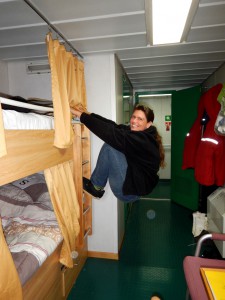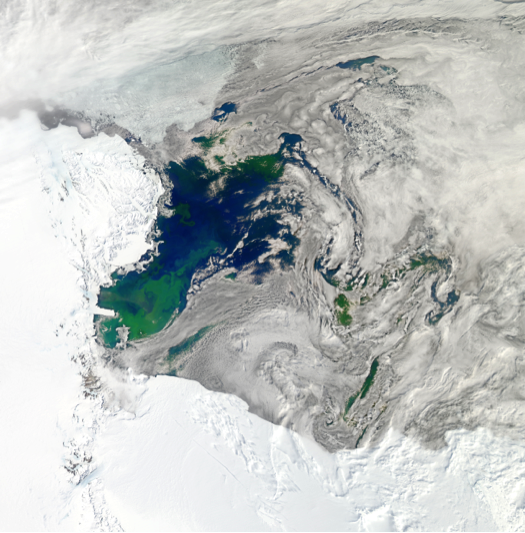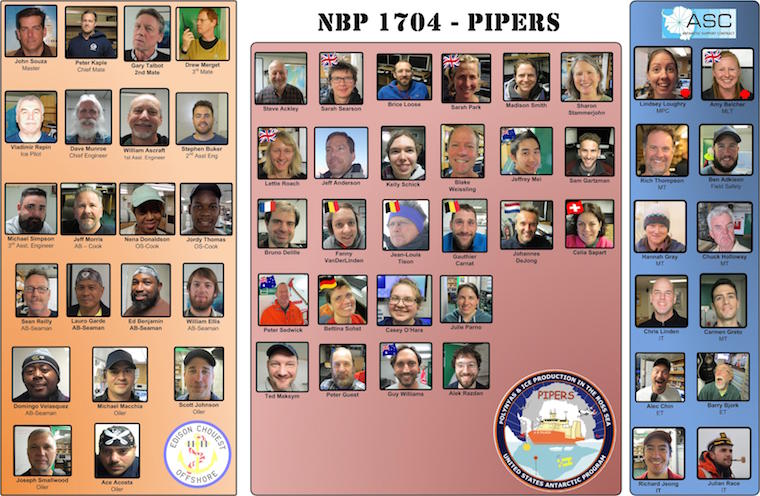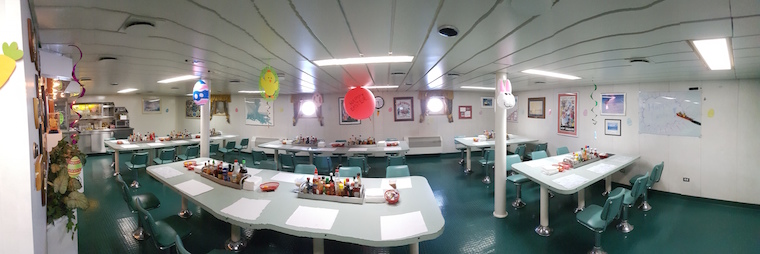(by Bettina – technician and lab manager in the OEAS department at ODU)
Life onboard a research vessel changes everyone’s tried and true daily routine completely. There are no 9-5 work-weeks or weekends. Safety comes first for everything. And recreation often happens only in the form of a few hours of sleep.
When a person, who is not connected to our line of work, hears that I work in the field of oceanographic research, the first picture conjured in their mind is usually of Cousteau, bikinis and dolphins. Reality could not be farther from this popular dream picture.
Only few oceanographic research expeditions (We call them “cruises” only among ourselves, as this invokes the vision of a Carnival trip) sail to warm waters, and almost all are focused on work, work, work. Ship time is precious, so it dictates our daily routine. 24 hour operations are the norm.
Most workdays are at the very least 12 hours long (if you are “lucky” and share a 24 hour workday with another person in watches). Often this stretches much beyond, even to work periods longer than 24 hours at times.
Safety is the one most important goal on any expedition. A ship, especially in remote areas (and it can’t get more remote than Antarctica), bears many hazards, and everyone on board needs to show constant vigilance to prevent injuries, damage, failure, etc. Working on a constantly moving platform alone can make normal tasks rather tricky.

Deployed equipment in rough seas.
The crew on research vessels is thoroughly trained in keeping us safe as well as in educating us. Usually the beginning of a trip is littered with safety briefings. On this trip we already sat through “General safety and hazard awareness”, “Ice safety”, “Zodiak rules and ladder training” etc., and of course the always present, weekly fire-drill! The first one happens right after departure, with a repeat every week.
This does have its advantages: When all we do is work, weekdays blend into each other, so a fire-drill tells us, which weekday it is. In our case here on the Nathaniel B. Palmer, Wednesday is fire-drill day. When the alarm bell rings around mid-day, grab your floatation device, survival suit, grab-bag with hat, sunscreen, water, important documents etc., and proceed to the muster station.

Emergency suit testing during a fire drill.
As time moves along, the faces seen at these gatherings tend to look increasingly tired. Some people even get ripped out of their bunks in the middle of their sleep.
Speaking of bunks: Accommodations are also much different than our cozy places at home, although the NBP is quite luxurious, compared to other research vessels. Staterooms are equipped with only the necessary, beds are bunk-style with two people to a room, and rather narrow. However, nothing beats the gentle rocking of a ship to lull you into sleep!

Bunk beds and their versatility.
This same rocking also turns showers into a whitewater experience. That bar inside the shower can come in quite handy, and toweling off can resemble yoga.
Another aspect to get used to is the background noise level. A steel ship carries any sound, including the engines, happily chirping echo sounder and human conversations. While some white noises, like the hum of diesel engines, can be soothing, others require acceptance or adjustment. One of the first things I usually do is de-squeaking and de-rattling my stateroom. Duct tape, cardboard and plastic wedges come in really handy here.
Privacy is hard to come by. If you imagine 300 feet of ship with nearly 70 people on it, you can understand how difficult it can be to find some me-time. People get inventive, though, and can be hiding in strange places. If you find them there, you won’t get more than a grunt. Privacy is sacred.
Food is provided on board. In fact, the cooks are usually some of the hardest working people on the ship. Feeding a herd of hungry sailors is no small feat.
Here on NBP we have the opportunity to consume four meals a day: 7:30 breakfast, 11:30 lunch, 17:30 dinner and 23:30 midrats (midnight rations), each an hour long. We are provided with the nutrition needed to keep chugging in the cold, harsh environment of Antarctica. However, on a 65 day tour like this one, certain food items do run out eventually. The bananas are usually the first to go, followed by other fruits and fresh vegetables, and later on yogurt and co. That’s when food moods start to drop. Many people bring their own “culinary happy places” in form of chocolate, espresso or cheese for example.
Even our daily clothing differs quite a bit from what can be seen on land. The pretense of “looking good” goes overboard quickly, when you realize that jeans and sneakers get (and stay) wet and cold, frilly clothing items get stuck in cables, nooks and crannies, and your good clothes will eventually all fall victim to the curse of the seafaring washing machine (rust spots, bleached colors and saggy fabric) and also collect grease spots and tears. But nobody really minds. If it is warm and comfortable AND protects you (hence the steel toed boots!), you wear it.
One popular entertainment on board are the newly introduced t-shirts at the beginning of a trip. Reading everyone’s shirts becomes a favorite pastime.
Finding entertainment can become rather inventive here. We are lucky and have a self-proclaimed “morale-team”. On Easter Sunday we all got to play bingo with the Easter bunny. A welcome distraction made possible by the fact that we are not in full station work mode, yet.
Additionally, the NBP offers a small gym, a sauna, a movie lounge with a good selection of movies, a library, and even (very limited, but workable) internet!
If we do get that precious moment to recreate, we enjoy it as much as we can.
While all this sea life may sound nearly unbearable to some of you, it is worth it, if you love the seagoing jobs! Nothing beats the ever-changing view of an endless ocean, your face in the wind, the occasional sights of amazing places and wildlife, the knowledge gained from new data and instrumentation, or the development of new friendships and of a somewhat dysfunctional family bond onboard, and, of course: Ocean sunsets!!!

Royal albatross
We may see more dark than sun on our fall/winter season trip in the southern hemisphere, but we are hoping for the aurora australis!
And ice has its own, ever-changing beauty and fascination.
Ask a sailor how life onboard truly is. You will hear some unusual stories. 



























